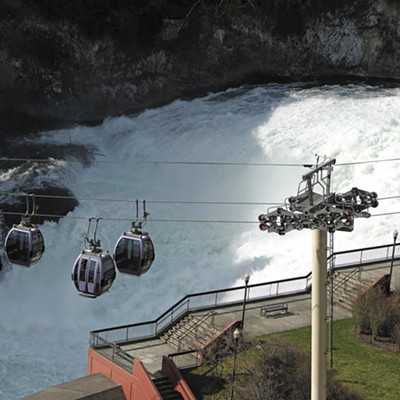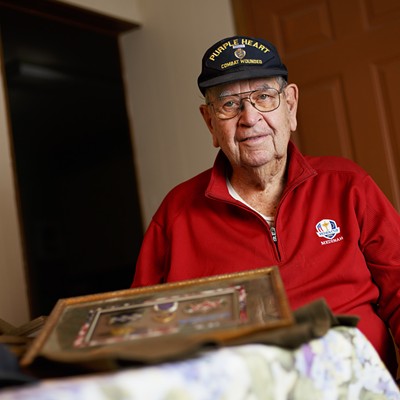Bring Back The Racks
[
{
"name": "Broadstreet - Instory",
"insertPoint": "5",
"component": "25846487",
"requiredCountToDisplay": "5"
},{
"name": "Broadstreet - Instory",
"insertPoint": "10",
"component": "25846487",
"requiredCountToDisplay": "10"
},{
"name": "Broadstreet - Instory",
"insertPoint": "15",
"component": "25846487",
"requiredCountToDisplay": "15"
},{
"name": "Broadstreet - Instory",
"insertPoint": "20",
"component": "25846487",
"requiredCountToDisplay": "20"
}
]
by Robert Herold
Why would a family committed to the importance of a vital downtown, for the very first time ever, make almost all its Christmas purchases out in the suburban malls? That's just what happened in December: Almost all of our Christmas dollars went north.
On the off chance that our shopping pattern isn't all that unique, perhaps an explanation would prove helpful to those who move the pieces in the downtown retail game.
Let's begin with what didn't contribute -- except marginally -- to our problem. I refer to parking. Availability of parking actually had nothing to do with our buying patterns. The fact is, finding parking spaces downtown isn't a problem.
Please note that I refer to parking availability, not "the parking experience." The parking experience remains more of a hassle than it should be, and, for most people, those little hassles do add up. Parking validation, too, remains an unnecessary annoyance. If you don't know the system, you have to ask. A hassle. Then you must stand in line. Another hassle.
Then there are those one-way streets. They pose another hassle. Too many drives around several blocks at a time, just to line up the right way. Certainly, by this time we all know that one-way streets are bad for on-street business, and since they require all that extra driving, they aren't even good for air quality.
We can live with minor hassles, however -- that's part of urban life. But what really cost the downtown our Christmas dollar were holes in the marketplace. My wife, Barre, who knows lots more about this than I do, argues that the old Crescent was always more important to the health of the downtown than Nordstrom. At the Crescent, the shopper could buy almost anything -- clothing, toys, electronic gadgets, sewing paraphernalia, office supplies, even large appliances. That selection brought people downtown, where they would often visit Nordstrom and spend a few bucks. Today, the options are far more limited. Barre's suggestion? If the business brain-trusters want a template to guide future plans, they could do a lot worse than study the old Crescent.
This year, three very obvious holes caused us to look elsewhere. They were:
1. No downtown Nordstrom Rack -- or Eddie Bauer Outlet, for that matter. We need those discounted prices, but we also need funky surroundings that only a downtown can provide -- like what we had in the old Nordstrom's basement.
Okay, we can't bring back that charming basement; but we have an empty building almost as good, only a couple of blocks to the south. You want discounted prices in funky surroundings, I give you the old Lamont's building. Perfect for a Rack of some kind. Let's face it, the Rack, like the old Crescent, brought us downtown. Once there, we would move to other shops and stores.
I have said it before, and I'll jump on my soapbox again: In Spokane, a Rack is the destination and the real store is the impulse buy. I know, they don't understand this logic in Bellevue, and at some point we veered toward Bellevue-style high-end retail. That's fine, and places like Pottery Barn and Restoration Hardware have been great additions we've all waited for years to get. However, in this economy especially, shoppers want discounts. We can no longer limit our thinking to the idea that we have to pick either discounters or mainstream retailers -- we need both to coexist side by side, prospering off one another.
2. Even small merchandise holes in the downtown marketplace can be of critical importance. You want to purchase a CD? Guess what? In today's upscale downtown Spokane, you can't find much of anything by way of a recording selection. (Boo Radley's, bless them, is about the only place.)
Which brings us to the major rub: Once we make our way all the way up to Barnes and Noble or Borders in search of that elusive CD, guess what? We don't leave. We just continue shopping. It might not even take all that large of a CD store to do the trick. The late, great Street Music served the purpose. Here was a tiny store, but the owner knew music, had good taste and would get what you wanted. Of course a Tower Records or Virgin Megastore would do quite nicely, too.
3. The other missing piece is equally obvious: children's toys. For a time, downtown shoppers had Annako Toys, and the Bon had a toy department -- but no longer. Today, if you want toys, you head up Division or out I-90. Once you have made the effort, again, you find reasons to stay and make purchases that you would rather make downtown. FAO Schwartz, anyone?
Downtown's on the right track, but a few fixes would go a long way. Fix the parking validation problems, minor as they may be, open up one-way streets, bring back the Rack, fill the critical holes in the downtown menu, and shoppers will have a reason to spend even more downtown.
Comments?
Send them to [email protected]
Why would a family committed to the importance of a vital downtown, for the very first time ever, make almost all its Christmas purchases out in the suburban malls? That's just what happened in December: Almost all of our Christmas dollars went north.
On the off chance that our shopping pattern isn't all that unique, perhaps an explanation would prove helpful to those who move the pieces in the downtown retail game.
Let's begin with what didn't contribute -- except marginally -- to our problem. I refer to parking. Availability of parking actually had nothing to do with our buying patterns. The fact is, finding parking spaces downtown isn't a problem.
Please note that I refer to parking availability, not "the parking experience." The parking experience remains more of a hassle than it should be, and, for most people, those little hassles do add up. Parking validation, too, remains an unnecessary annoyance. If you don't know the system, you have to ask. A hassle. Then you must stand in line. Another hassle.
Then there are those one-way streets. They pose another hassle. Too many drives around several blocks at a time, just to line up the right way. Certainly, by this time we all know that one-way streets are bad for on-street business, and since they require all that extra driving, they aren't even good for air quality.
We can live with minor hassles, however -- that's part of urban life. But what really cost the downtown our Christmas dollar were holes in the marketplace. My wife, Barre, who knows lots more about this than I do, argues that the old Crescent was always more important to the health of the downtown than Nordstrom. At the Crescent, the shopper could buy almost anything -- clothing, toys, electronic gadgets, sewing paraphernalia, office supplies, even large appliances. That selection brought people downtown, where they would often visit Nordstrom and spend a few bucks. Today, the options are far more limited. Barre's suggestion? If the business brain-trusters want a template to guide future plans, they could do a lot worse than study the old Crescent.
This year, three very obvious holes caused us to look elsewhere. They were:
1. No downtown Nordstrom Rack -- or Eddie Bauer Outlet, for that matter. We need those discounted prices, but we also need funky surroundings that only a downtown can provide -- like what we had in the old Nordstrom's basement.
Okay, we can't bring back that charming basement; but we have an empty building almost as good, only a couple of blocks to the south. You want discounted prices in funky surroundings, I give you the old Lamont's building. Perfect for a Rack of some kind. Let's face it, the Rack, like the old Crescent, brought us downtown. Once there, we would move to other shops and stores.
I have said it before, and I'll jump on my soapbox again: In Spokane, a Rack is the destination and the real store is the impulse buy. I know, they don't understand this logic in Bellevue, and at some point we veered toward Bellevue-style high-end retail. That's fine, and places like Pottery Barn and Restoration Hardware have been great additions we've all waited for years to get. However, in this economy especially, shoppers want discounts. We can no longer limit our thinking to the idea that we have to pick either discounters or mainstream retailers -- we need both to coexist side by side, prospering off one another.
2. Even small merchandise holes in the downtown marketplace can be of critical importance. You want to purchase a CD? Guess what? In today's upscale downtown Spokane, you can't find much of anything by way of a recording selection. (Boo Radley's, bless them, is about the only place.)
Which brings us to the major rub: Once we make our way all the way up to Barnes and Noble or Borders in search of that elusive CD, guess what? We don't leave. We just continue shopping. It might not even take all that large of a CD store to do the trick. The late, great Street Music served the purpose. Here was a tiny store, but the owner knew music, had good taste and would get what you wanted. Of course a Tower Records or Virgin Megastore would do quite nicely, too.
3. The other missing piece is equally obvious: children's toys. For a time, downtown shoppers had Annako Toys, and the Bon had a toy department -- but no longer. Today, if you want toys, you head up Division or out I-90. Once you have made the effort, again, you find reasons to stay and make purchases that you would rather make downtown. FAO Schwartz, anyone?
Downtown's on the right track, but a few fixes would go a long way. Fix the parking validation problems, minor as they may be, open up one-way streets, bring back the Rack, fill the critical holes in the downtown menu, and shoppers will have a reason to spend even more downtown.
Comments?
Send them to [email protected]


















